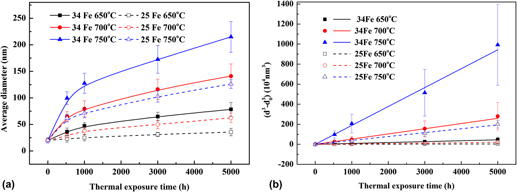Crossref Citations
This article has been cited by the following publications. This list is generated based on data provided by
Crossref.
Wang, Changshuai
Guo, Yongan
Guo, Jianting
and
Zhou, Lanzhang
2016.
Microstructural characteristics and mechanical properties of a Mo modified Ni–Fe–Cr based alloy.
Materials Science and Engineering: A,
Vol. 675,
Issue. ,
p.
314.
Wang, Changshuai
Guo, YongAn
Guo, Jianting
and
Zhou, Lanzhang
2016.
Microstructural changes and their effect on tensile properties of a Ni-Fe based alloy during long-term thermal exposure.
Materials Science and Engineering: A,
Vol. 670,
Issue. ,
p.
178.
Wang, Changshuai
Wang, Tingting
Guo, Jianting
Zhou, Lanzhang
Zhao, Haiping
and
Xu, Songqian
2017.
Energy Materials 2017.
p.
143.
Sun, Yanle
Fu, Liming
Fu, Zhiqiang
Shan, Aidang
and
Lavernia, Enrique J.
2017.
Enhanced thermal stability and ductility in a nanostructured Ni-based alloy.
Scripta Materialia,
Vol. 141,
Issue. ,
p.
1.
Wu, Dong
Li, Dianzhong
and
Lu, Shanping
2018.
Microstructural evolution and mechanical property of a Ni-Fe-based weld metal during long-term exposure at 650 °C and 700 °C.
Materials Science and Engineering: A,
Vol. 716,
Issue. ,
p.
240.
Wu, Dong
Li, Dianzhong
and
Lu, Shanping
2018.
Effect of Cr content on the microstructural stability and impact-toughness evolution of a Ni-Fe-based weld metal.
Journal of Alloys and Compounds,
Vol. 749,
Issue. ,
p.
465.
Wang, Changshuai
Wu, Yunsheng
Guo, YongAn
Guo, Jianting
and
Zhou, Lanzhang
2019.
Precipitation behavior of sigma phase and its influence on mechanical properties of a Ni-Fe based alloy.
Journal of Alloys and Compounds,
Vol. 784,
Issue. ,
p.
266.
Chu, Tongjiao
Xu, Huali
Cui, Haichao
and
Lu, Fenggui
2019.
Research on the coarsening mechanism of precipitations and its effect on toughness for nickel-based weld metal during thermal aging.
Journal of Materials Research,
Vol. 34,
Issue. 15,
p.
2705.
Hou, Kunlei
Ou, Meiqiong
Wang, Min
Li, Haoze
Ma, Yingche
and
Liu, Kui
2019.
Precipitation of η phase and its effects on stress rupture properties of K4750 alloy.
Materials Science and Engineering: A,
Vol. 763,
Issue. ,
p.
138137.
Wu, Yunsheng
Qin, Xuezhi
Wang, Changshuai
and
Zhou, Lanzhang
2021.
Microstructural evolution and its influence on the impact toughness of GH984G alloy during long-term thermal exposure.
Journal of Materials Science & Technology,
Vol. 60,
Issue. ,
p.
61.
Li, Linxu
Gong, Xiufang
Wang, Changshuai
Wu, Yunsheng
Yu, Hongyao
Su, Haijun
and
Zhou, Lanzhang
2021.
Correlation Between Phase Stability and Tensile Properties of the Ni-Based Superalloy MAR-M247.
Acta Metallurgica Sinica (English Letters),
Vol. 34,
Issue. 6,
p.
872.
Guo, QianYing
Ji, KangKang
Zhang, Teng
Qiao, ZhiXia
Li, Chong
Li, Jun
Liu, ChenXi
and
Liu, YongChang
2022.
Precipitates evolution and tensile behavior of wrought Ni-based ATI 718Plus superalloy during long-term thermal exposure.
Science China Technological Sciences,
Vol. 65,
Issue. 6,
p.
1283.
Zhang, Xiangxiang
Wang, Changshuai
Wu, Yunsheng
and
Zhou, Lanzhang
2022.
Effect of phosphorus segregation on carbides and creep damage of Ni–Fe-based GH984G alloy.
Journal of Materials Research and Technology,
Vol. 19,
Issue. ,
p.
2018.
Huang, Yeshun
Zhang, Rui
Zhou, Zijian
Yan, Jingbo
Yuan, Yong
Gu, Yuefeng
Cui, Chuanyong
Zhou, Yizhou
and
Sun, Xiaofeng
2022.
Effect of long-term aging on microstructural stability and tensile deformation of a Fe–Ni-based superalloy.
Materials Science and Engineering: A,
Vol. 847,
Issue. ,
p.
143298.
Wang, Y.C.
Mei, Q.S.
Zhang, P.
Yan, J.B.
Ma, Y.
Liao, L.Y.
Xu, T.
and
Yuan, Y.
2023.
Effect of nitrogen on the microstructure evolution and mechanical properties of Ni-Fe base superalloys during long-term thermal exposure.
Materials Characterization,
Vol. 203,
Issue. ,
p.
113058.
Guo, C.H.
Zhang, P.
Zhou, Y.L.
Li, L.M.
Yin, H.F.
Yan, J.B.
Diao, W.Z.
Li, P.
and
Yuan, Y.
2023.
Microstructural evolution and yield strength of a novel precipitate-strengthened Fe-based superalloy during thermal aging at 700 °C.
Intermetallics,
Vol. 163,
Issue. ,
p.
108077.
Cheng, Sihan
Wang, Jiaqi
Wu, Yunsheng
Qin, Xuezhi
and
Zhou, Lanzhang
2023.
Microstructure, thermal stability and tensile properties of a Ni–Fe–Cr based superalloy with different Fe contents.
Intermetallics,
Vol. 153,
Issue. ,
p.
107785.
Li, Shaowei
Liu, Fang
Si, Tianxiao
and
Sun, Wenru
2024.
Incommensurate modulated structure and nano-sized γ′ phase induced by Fe during creep at 650 ℃ in Nickel-based model alloys.
Scripta Materialia,
Vol. 243,
Issue. ,
p.
115995.






